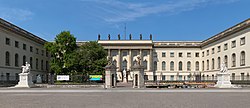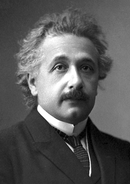
The University of Göttingen, officially the Georg August University of Göttingen, is a distinguished public research university in the city of Göttingen, Germany. Founded in 1734 by George II, King of Great Britain and Elector of Hanover, it began instruction in 1737 and is recognized as the oldest university in Lower Saxony.
TU Dresden, also as the Dresden University of Technology, is a public research university in Dresden, Germany. It is the largest institute of higher education in the city of Dresden, the largest university in Saxony and one of the 10 largest universities in Germany with 32,389 students as of 2018.
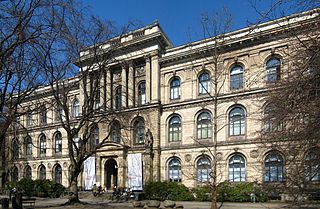
The Natural History Museum is a natural history museum located in Berlin, Germany. It exhibits a vast range of specimens from various segments of natural history and in such domain it is one of three major museums in Germany alongside Naturmuseum Senckenberg in Frankfurt and Museum Koenig in Bonn.

Saarland University is a public research university located in Saarbrücken, the capital of the German state of Saarland. It was founded in 1948 in Homburg in co-operation with France and is organized in six faculties that cover all major fields of science. In 2007, the university was recognized as an excellence center for computer science in Germany.

The Gottfried Wilhelm Leibniz Prize, or Leibniz Prize, is awarded by the German Research Foundation to "exceptional scientists and academics for their outstanding achievements in the field of research". Since 1986, up to ten prizes have been awarded annually to individuals or research groups working at a research institution in Germany or at a German research institution abroad. It is considered the most important research award in Germany.

The Kiel Institute for the World Economy is an independent, non-profit economic research institute and think tank based in Kiel, Germany. In 2017, it was ranked as one of the top 50 most influential think tanks in the world and was also ranked in the top 15 in the world for economic policy specifically. German business newspaper, Handelsblatt, referred to the institute as "Germany's most influential economic think tank", while Die Welt, stated that "The best economists in the world are in Kiel".
The RWI – Leibniz-Institut für Wirtschaftsforschung, Essen is an independent economic research institute and think tank in Essen, Germany. Founded in 1926, the RWI maintains a non-profit status, mainly funded through public means while also receiving third-party-fundings. It conducts research on economic development, assists policy-making, and fosters economic literacy for the public. The RWI currently employs 120 people and is part of the Leibniz Association, a group of non-university research institutes in Germany.
Justus Mühlenpfordt was a German nuclear physicist. He received his doctorate from the Technische Hochschule Carolo-Wilhelmina zu Braunschweig, in 1936. He then worked in Gustav Hertz's laboratory at Siemens. In 1945, he was sent to Institute G, near Sukhumi and under the directorship of Hertz, to work on the Soviet atomic bomb project. Released from Soviet Union, Mühlenpfordt arrived in East Germany in 1955. He was appointed director of the Institut für physikalische Stofftrennung of the Academy of Sciences, in Leipzig. From 1969 until his retirement in 1974, Mühlenpfordt was director of the Forschungsbereiches Kern- und Isotopentechnik der Akademie.
The Berlin Graduate School of Natural Sciences and Engineering (BIG-NSE) is part of the Cluster of Excellence "Unifying Concepts in Catalysis" (UniCat) founded in November 2007 by the Technical University of Berlin and five further institutions in the Berlin area within the framework of the German government‘s Excellence Initiative.
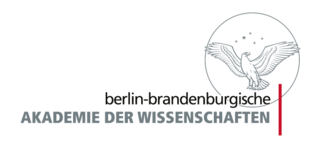
The Berlin-Brandenburg Academy of Sciences and Humanities, abbreviated BBAW, is the official academic society for the natural sciences and humanities for the German states of Berlin and Brandenburg. Housed in three locations in and around Berlin, Germany, the BBAW is the largest non-university humanities research institute in the region.
The Karl-Scheel-Preis is an award given annually by the Physikalische Gesellschaft zu Berlin, a regional association of the Deutsche Physikalische Gesellschaft, for outstanding scientific work. The prize was established through an endowment by the German physicist Karl Scheel and his wife Melida. Recipients are awarded with the Karl-Scheel Medal and 5.000 Euros. The Karl-Scheel Medal in bronze was designed by the German sculptor Richard Scheibe and has a diameter of 12 cm.
The Deutsche Hochschule für Politik (DHfP), or German Academy for Politics, was a private academy in Berlin, founded in October 1920. It was integrated into the Faculty for Foreign Studies of the Friedrich-Wilhelms-Universität in 1940, was re-founded in 1948 and turned into the Otto-Suhr-Institut of the Freie Universität Berlin in 1959.
The Zurich University of Applied Sciences located in the city of Winterthur, with facilities in Zurich and Wädenswil, is one of the largest University of Applied Sciences in Switzerland and is part of the Zürcher Fachhochschule.
Annette Zippelius is a German physicist at the University of Göttingen. In 1998 she became a Gottfried Wilhelm Leibniz Prize winner. Her research focuses on complex fluids and soft matter – materials that are intermediate between conventional liquids and solids. Examples are glasses, polymeric melts or solutions, gels and foams, but also granular matter. With her research group she aims at elucidating the underlying principles of self-organization that govern their behavior.
Rolf Landsberg was a German Professor of Physical Chemistry.

Michael Roth was a German engineer and professor of automation, specializing in microprocessor technology, computer science and sociology as well as philosophy of science. He was one of the pioneers in the area of computer engineering in Germany.
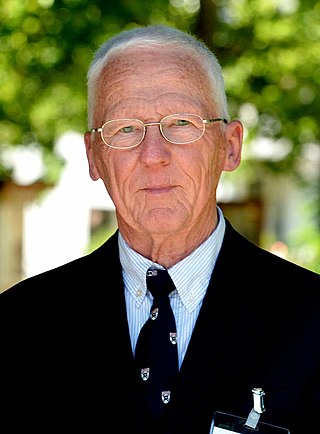
Geerd Heinrich Friedrich Diercksen is a German theoretical chemist and a pioneer in computational chemistry. In 1963 he was awarded his PhD, supervised by Heinz-Werner Preuß at the Johann Wolfgang Goethe-Universität in Frankfurt am Main, in 1973 he was awarded his habilitation in Chemistry by the Technische Universität München and in 1983 he was appointed professor. From 1965 to 2001 he worked as scientific staff at the Max-Planck-Institut für Astrophysik and since 2001 he works there as scientist emeritus.

Open access to scholarly communication in Germany has evolved rapidly since the early 2000s. Publishers Beilstein-Institut, Copernicus Publications, De Gruyter, Knowledge Unlatched, Leibniz Institute for Psychology Information, ScienceOpen, Springer Nature, and Universitätsverlag Göttingen belong to the international Open Access Scholarly Publishers Association.

Sabine Kunst is a German engineer, academic and politician who has been serving as chairwoman of the Joachim Herz Foundation since 2022.
